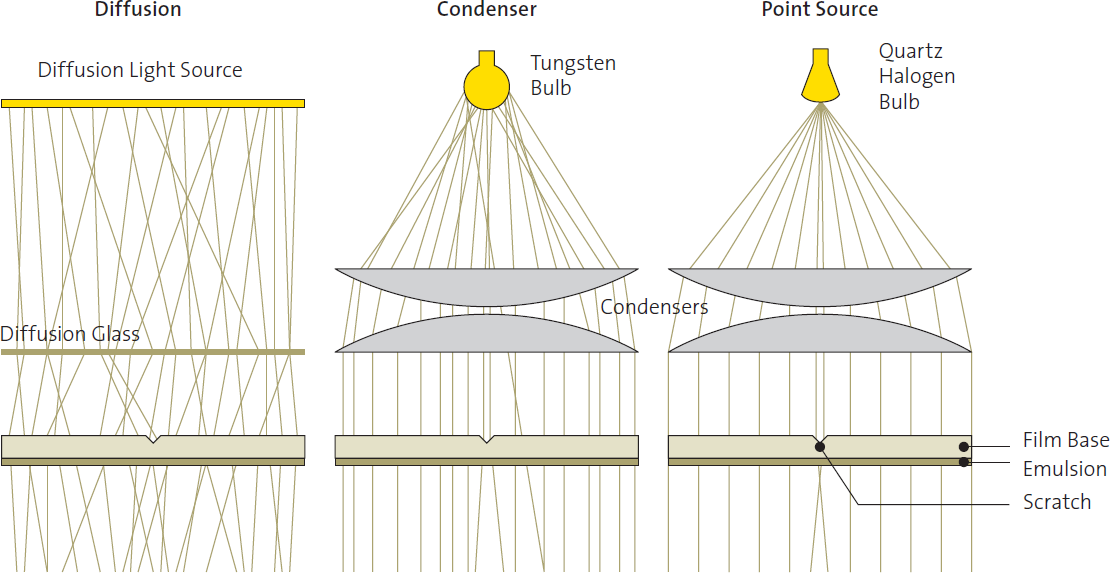APPENDIX 2
Enlarger Light Sources
![]()
THERE ARE THREE BASIC TYPES OF ENLARGER LIGHT SOURCES: diffusion, condenser, and point source. Each has its proponents, and each has characteristics that differ from the others. Diffusion gives the softest contrast of the three, point source the harshest, and condenser somewhat closer to point source than to diffusion—perhaps two-thirds of the way to point source.
With diffused illumination, such as a cold light source (so named because the fluorescent-type light source puts out little heat in relation to its light output) or a bulb diffusion source (such as the color/light heads of the Saunders LPL, Omega, and Beseler enlargers, or the variable contrast heads made by Saunders or Oriental, among others), the gradations of contrast are softer and smoother, especially in the highlights. A negative that will print with barely perceptible highlight detail from a diffused light source will lose that detail if printed with a condenser or point source enlarger. A point source enlarger is one that has a small, intensely bright lamp, such as a projector-style quartz-halogen bulb placed far from two glass condensers, which collimate the light and send parallel rays down through the negative. This light creates the sharpest contrast of all. A negative that will print with barely perceptible highlight detail with a point source light will lose a slight degree of “snap” in those highlights with a condenser source, and the same highlights will be somewhat grayed with a diffusion source.
The condenser enlarger is effectively a “poor man’s point source enlarger”. It has the same familiar glass condensers as the point source, but it uses a conventional bulb as its light source, and the bulb is placed relatively close to the condensers. The width of the bulb itself, and its proximity to the condensers, prevents the condensers from perfectly collimating the light, but a fairly good approximation of true collimated light is achieved.
Diagram A-2.1: Enlarger light sources Diffusion (left); Condenser (center); Point Source (right)
The light from the diffusion enlarger (left) reaches the emulsion beneath the scratch in the base (base thickness is exaggerated in diagram) because light is refracted through the film base from all directions. With the condenser and point source, parallel beams of light refract away from the emulsion beneath the base. The scratch will be harder to see under diffusion enlargement.
Photographers argue the merits of these light sources, but the fact is that each works well as long as the negative made for it is appropriate. Use of a point source enlarger necessitates a lower contrast negative than one required for diffusion. As long as the entire system is compatible with itself, it will do the job.
Some people claim that the diffusion enlarger has less sharpness than the point source or even the condenser. It may be true, but I don’t feel disappointment with lack of sharpness in my prints, nor was I unhappy with Ansel’s sharpness. If a sharpness difference does exist, it may be measurable by instruments, but is not readily apparent to the eye.
The diffusion enlarger can claim superiority in one respect: slight scratches in the film base will be rendered invisible, but will be visible with the condenser or point source. The reason is that light from the diffuser hits the negative from all angles, is then refracted crazily through the thickness of the negative’s base before hitting the emulsion, and continuing on to the focusing lens. Slight scratches in the film’s base will cause different refraction patterns through the thickness of the negative, but light will still go through all portions of the negative. With the condenser, and even more with the point source, the collimated light hits the scratch and is diverted to the side, while light hitting elsewhere on the negative’s surface goes essentially straight through. So, less light hits the emulsion below the scratch, and it is recorded as a lighter line on the print.
All negatives can be scratched, but if film holders are kept clean and pressure plates on roll film holders are cleaned regularly, and the negative is handled with care, scratches will be held to a minimum. These precautions should be followed by all photographers, under any circumstances, so do not use this as an excuse to shy away from condenser or point source enlarger light sources.

